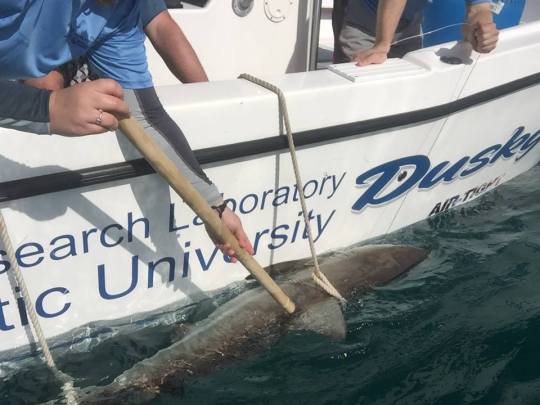#snow birds
Blacktip sharks are also, in some way, what we would call “snow birds.” Like many retired Canadians and Northeasterners, blacktips migrate down south every winter to get out of the cold and enjoy the Florida weather conditions.
Over10,000 blacktip sharks have been spotted this week swimming swiftly along the east coast of Florida, around the Palm Beach area. While this year’s migration has been picked up by many national media outlets, this is not a new phenomenon, and it happens every year during the winter months, where this particular species likes to migrate to warmer waters.

(Each one of these black dots is a 2-meters blacktip shark. Photo credit to @sharkmigration on Instagram)
This year however, they are further north than usual, and have been spotted as close as 100m off the beach. They usually like to venture further south, around the Miami and Fort Lauderdale area, but it looks like they have elected Palm Beach this year for their hangout spot. The sharks are also a little late compared to normal, with the species normally showing up in the area in mid-January.
There’sspeculation that this shift could be triggered by El Niño keeping the East Coast unseasonably warm at the end of last year, as well as ocean temperatures increasing further from the equator. The sharks are probably finding the waters around Palm Beach perfectly suitable, and may not feel the need to keep swimming south.
Shark scientists at Florida Atlantic University (FAU) have been doing aerial surveys of the migration since 2011, and have also recently started tagging numerous blacktips to figure out why they are there, how long they stay, or from where they come.
“This is a particularly compelling migration, because it happens so close to shore in such clear waters, and because it happens in such a popular winter destination for people,” explainedlead scientist Stephen Kajiura of FAU.
Kajiura hopes to understand why the sharks have stayed in the Palm Beach County area this year, and has tagged 32 sharks so far. He is hoping to tag 60 sharks in total so he can observe where exactly the sharks go in their migration patterns. This is the second year he and his lab have tagged sharks with geolocating transmitters.

(FAU Shark Migration team tagging one of the blacktip sharks with a NOAA dart tag. Photo credit to FAU Shark Migration Facebook Page)
Despite the close proximity of the sharks to the beaches, nothing has been closed off so far, and the local population is very well aware of this annual phenomenon and what precautions to take to avoid any incident.
The sharks are usually in the area from January to mid-March, and then are expected to swim slowly back north through the Carolinas.

(Photo credit: Mark Mohlmann)



